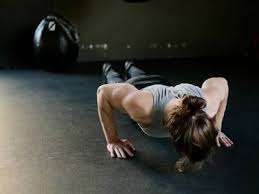Bodyweight exercises have long been touted as a convenient and effective way to stay fit without the need for expensive gym memberships or bulky equipment.
But with the growing popularity of weightlifting and resistance training, many people wonder whether bodyweight exercises are truly effective for building strength, endurance, and muscle mass.
Are these exercises a waste of time if you aren’t using weights, or can you still achieve significant fitness gains through bodyweight workouts alone?
In this article, I will explore the science behind bodyweight training, its benefits, limitations, and whether or not it can truly hold its own against weight training.
“Are Bodyweight Exercises a Waste of Time Without Weights” Article Index:
- What Are Bodyweight Exercises?
- Upper Body Weight Training Exercises vs. Bodyweight Exercises
- The Effectiveness of a Full Bodyweight Workout at Home
- Lower Body Weight Workout vs. Bodyweight Training
- Can You Build Muscle with Workouts Using Body Weight?
- Calisthenics Workout Plan for Beginners
- FAQs on Bodyweight Exercises for Fat Loss
- The Inverted Row and Its Importance
- Conclusion: Are Bodyweight Exercises Worth It Without Weights?
What Are Bodyweight Exercises?
Bodyweight exercises involve using your own body as resistance to perform movements that target different muscle groups.
These exercises include push-ups, squats, lunges, pull-ups, planks, and burpees, among others. The beauty of bodyweight training lies in its simplicity and accessibility — you don’t need any equipment, and you can perform these exercises almost anywhere.
While many associate weight training with lifting dumbbells or barbells, bodyweight exercises can be just as effective, especially for beginners.
They not only build strength but also improve balance, coordination, and flexibility.
However, some argue that bodyweight workouts lack the progressive overload necessary for building significant muscle mass. So, is this a valid criticism?

Upper Body Weight Training Exercises vs. Bodyweight Exercises
Upper body weight training exercises, such as bench presses, shoulder presses, and bicep curls, are commonly used to build strength and size.
These exercises allow for progressive overload by increasing the weight over time, which is essential for muscle hypertrophy (growth).
However, bodyweight exercises like push-ups, dips, and handstands can also be highly effective at targeting the upper body.
Studies have shown that exercises using body weight can produce similar strength gains to those using external weights when performed correctly and with progressive variations.
For instance, starting with standard push-ups and gradually moving to more challenging variations, such as decline push-ups or one-arm push-ups, can provide the necessary stimulus for muscle growth.
The Effectiveness of a Full Bodyweight Workout at Home
A full bodyweight workout at home can target all major muscle groups without the need for gym equipment.
Movements like squats, lunges, push-ups, planks, and burpees engage the core, legs, chest, back, and arms, providing a well-rounded fitness routine.
Scientific evidence suggests that bodyweight workouts can be highly effective for improving cardiovascular endurance, strength, and flexibility.
A study published in the Journal of Strength and Conditioning Research found that participants who followed a structured bodyweight training plan saw improvements in both muscle strength and endurance.
The key is to maintain proper form, increase repetitions, and incorporate more challenging variations over time. I also feel that Losing Extra Body Fat via Smoothie Diet is vital for building lean muscle mass.
Lower Body Weight Workout vs. Bodyweight Training
Lower body weight workouts, such as barbell squats, deadlifts, and lunges with added weights, are often favored for building lower body strength and power.
While these exercises allow for significant muscle growth due to the heavy loads involved, bodyweight training exercises like squats, lunges, and step-ups can also be effective for targeting the legs and glutes.
The primary difference is that weight-based exercises can increase muscle size more quickly due to the ability to add heavy resistance.
However, studies have shown that bodyweight training is still effective for lower body strength when performed at high intensity or with added difficulty, such as by using single-leg variations or increasing reps.
Can You Build Muscle with Workouts Using Body Weight?
One of the biggest questions surrounding bodyweight exercises is whether they can build muscle as effectively as weightlifting.
The short answer is: yes, but with limitations.
Muscle hypertrophy requires progressive overload, which means gradually increasing the resistance on your muscles over time.
While it’s easier to achieve this with weights (by simply adding more weight), bodyweight training can still provide the necessary challenge through advanced movements and increased reps.
For example, transitioning from regular squats to pistol squats (single-leg squats) can significantly increase the difficulty of the exercise, leading to muscle growth.
A Journal of Sports Science and Medicine study revealed that high-repetition bodyweight exercises can stimulate muscle growth, especially for beginners and those focusing on endurance.
However, as you progress, you may eventually need to incorporate weights or resistance bands for further gains.

Calisthenics Workout Plan for Beginners
For those new to bodyweight training, a calisthenics workout plan for beginners can be an excellent way to build a foundation of strength, mobility, and endurance. It also helps initiate muscle hypertrophy.
Calisthenics involves exercises that use your body weight, such as push-ups, pull-ups, dips, and squats, all of which help improve muscle coordination and flexibility.
Here is a simple calisthenics workout guide for beginners:
- Push-ups: 3 sets of 10-15 reps
- Squats: 3 sets of 15-20 reps
- Planks: 3 sets of 30-60 seconds
- Lunges: 3 sets of 12 reps per leg
- Inverted Row: 3 sets of 8-10 reps
This plan targets all major muscle groups and helps build the strength needed to progress to more challenging exercises over time.
>>> Want to Lose Weight Like I Did??? Check Out My “Secret Fat Loss Smoothie Recipe” TODAY! <<<
The Inverted Row and Its Importance
The inverted row is a versatile bodyweight exercise that offers numerous benefits for individuals at various fitness levels.
Here is an in-depth look at its advantages:
-
Comprehensive Muscle Engagement: This exercise primarily targets the upper back muscles, including the trapezius, latissimus dorsi, and rhomboids. It also engages the posterior deltoids, biceps, and forearm flexors, contributing to overall upper body strength. According to Healthline, inverted rows are one of the best bodyweight exercises for strengthening the pulling muscles without the need for heavy equipment.
-
Enhanced Scapular Retraction: Performing inverted rows improves scapular retraction, which refers to the movement of the shoulder blades toward the spine. This movement is essential for shoulder stability and posture, especially for individuals who spend long hours sitting or performing push-dominant exercises, as noted by Healthline.
-
Progression Toward Pull-Ups: For those aiming to master pull-ups, inverted rows serve as an effective preparatory exercise. They develop the necessary back and arm strength in a horizontal plane, making the transition to vertical pulling movements more achievable. According to BarBend, training with inverted rows consistently improves overall pulling mechanics.
-
Adaptability for All Fitness Levels: The inverted row can be modified for beginners and advanced athletes alike. Adjusting the body angle or the height of the bar alters the difficulty, allowing for progressive overload. Muscle & Fitness highlights how this exercise can be used at different difficulty levels based on an individual’s fitness progress.
-
Improved Grip Strength: Maintaining a firm hold during inverted rows enhances grip endurance, which is beneficial for various other exercises and daily activities. BarBend reports that grip strength improvements from inverted rows translate well to exercises like deadlifts and pull-ups.
-
Core Stability Development: Keeping the body in a straight line during the movement requires core engagement, promoting better trunk stability and functional strength. According to Men’s Health, inverted rows are an excellent exercise for reinforcing core activation alongside upper body strength.
-
Posture Correction: Regularly incorporating inverted rows into a workout routine can counteract the effects of prolonged sitting and poor posture by strengthening the upper back and encouraging proper spinal alignment. BarBend notes that this exercise is particularly beneficial for those suffering from postural imbalances due to extended desk work.
Incorporating inverted rows into a fitness regimen can lead to significant improvements in strength, posture, and overall physical performance. Their adaptability and effectiveness make them a valuable addition to any workout program.
FAQS on Bodyweight Exercises for Weight Loss
Q-1: If I don’t use weights, can bodyweight moves still build real strength?
A-1: Yes—strength is about progressive overload, not metal plates. You can increase load by changing leverage (knees to full push-ups to feet-elevated; squats to pistols), slowing tempo (5–0–5 counts), adding pauses at weak ranges, and extending sets with rest-pause clusters. These variables raise mechanical tension and motor-unit recruitment similarly to adding kilos—just be deliberate with progression and track reps-in-reserve.
Q-2: What about muscle growth—aren’t bodyweight sets too “light” for hypertrophy?
A-2: Hypertrophy needs effort close to fatigue, not a barbell specifically. High-effort sets of push-ups, split squats, dips, chin-up regressions, and Nordic curls can drive growth when you approach 1–3 reps shy of failure. Use harder variations as you improve, chase a total of ~10–20 quality sets per muscle weekly, and rotate angles (elevated feet, archer patterns) to distribute stress and keep stimulus novel.
Q-3: Do bodyweight exercises help bones and connective tissue, or do I need heavy lifting for that?
A-3: Your skeleton and tendons respond to strain rate and direction as much as absolute load. Jumps, hops, bounds, and drop-landing drills (scaled carefully) create high-rate forces that bones “notice.” Isometrics (long wall sits, mid-range calf holds) and slow eccentrics (e.g., 5–8 sec down on pull-ups) strengthen tendons by boosting collagen synthesis and stiffness—great foundations before adding external load.
Q-4: Can I improve cardio-metabolic health with only bodyweight work?
A-4: Absolutely. Circuit formats (e.g., 40s on/20s off of squats, rows, push-ups, mountain climbers) elevate heart rate, VO₂, and insulin sensitivity while preserving muscle. Mix steady sessions (longer, conversational pace flows) with interval sessions (short, hard bursts). Add “movement snacks” of 2–5 minutes after meals to blunt glucose spikes—consistency matters more than session length.
Q-5: When do weights become the better tool—and how do I know I’ve outgrown bodyweight alone?
A-5: If you cannot progress reps/tempo/leverage across 2–3 weeks, or upper-body pulling/leg work no longer reaches near-failure in ~6–20 reps even with hard variations, it is time for load. Keep your bodyweight base (mobility, plyos, isometrics) and add dumbbells, kettlebells, or a barbell for precise loading jumps. Think of weights as fine-tuning—bodyweight built the engine; external load dials in the horsepower.

Are Bodyweight Exercises Worth It Without Weights?
So, are bodyweight exercises a waste of time if you’re not using weights?
The evidence suggests otherwise. While bodyweight workouts may not provide the same level of muscle hypertrophy as heavy weight training, they are far from ineffective.
Bodyweight training offers a host of benefits, including improved strength, endurance, flexibility, and coordination, and can be scaled to match any fitness level.
For beginners, bodyweight exercises are an excellent starting point, providing a foundation of strength and mobility that can be built upon.
For more advanced individuals, combining bodyweight training with additional resistance (such as weights, planks for core stability and weight loss or resistance bands) can yield even greater results.
Ultimately, bodyweight exercises are not a waste of time. They can be highly effective when performed consistently and with proper progression.
The key is to challenge yourself, maintain good form, and incorporate variety in your routine to continue seeing results.
References: